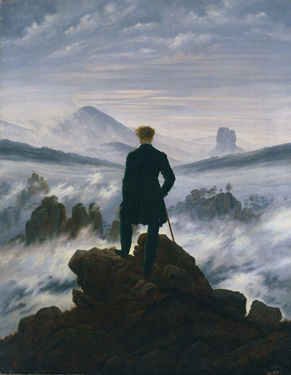
Some paintings attract and excite due to their special inner magic, even those who have not studied pictorial art. One of these artworks is the oil painting Wanderer above the Sea of Fog, created in 1818 by the German artist Caspar David Friedrich. In the center of the picture, a man, whom a viewer sees from the back, stands on the edge of a cliff, leaning on a stick and peering into the landscape, hidden by fog. This painting, written within the framework of romanticism, is one of the significant of Friedrich’s works and a symbol of romanticism, embodying the spirit of the era and the peculiarities of the author’s style.
Since the painting was created during the heyday of romanticism, it reflects its essence and main features through the prism of the author’s vision. The picture is characterized by the world’s perception at the level of feelings and subconsciousness (Shut, 2021). In the man depicted by Friedrich, it is possible to see several traits of the Byronic type of hero: he is proud and refined, as shown by his posture, mysterious, and, probably, lonely. Like many representatives of romanticism, this man may be trying to find his place in life and harmony with nature. The picture is based on the cult of nature, its rebellious essence: even being on a dais, the person seems to be nothing more than a tiny particle with no power over the elements. As a representative of this movement in art, Caspar David Friedrich brought several peculiarities into romanticism: the melancholy contemplation of nature and the symbolic implication of even those scenes that seem ordinary (Shut, 2021). Therefore, Wander above the Sea of Fog is an iconic painting that combines the features of romanticism and the unique style of Friedrich.
It would be wrong to judge the artwork without considering the context in which it was created. As already mentioned, the stylistic influences of that period have significantly shaped the painting. This picture is “the expression of a particular moment in art history in which nature offers a vision of the ‘sublime’, a subtle mixture of natural beauty and deep feelings” (Shut, 2021, p. 64). Along with stylistic influences, this work was also shaped by literary (use of Byronic hero) and philosophical ones. Wanderer above the Sea of Fog in its “iconic symbolism of self-reflection on an uncertain future” is a “fitting visual metaphor” that was popular among artists and philosophers of that time (Robinson, 2020, p. 1). The context in which the painting was written had a significant impact on how it turned out to look.
Knowing that Wanderer above the Sea of Fog was painted in the era of romanticism, a person can quickly realize its theme and content. Perceiving the work as part of romanticism, viewers can discover the profound interpretation: it is the author’s view of the unity of the greatness of nature and the feelings of an ordinary person. Without knowing the context of creation, it is possible to take the work too literally: a man stands on the top of a cliff and contemplates nature. Only understanding Friedrich’s philosophical desire to create an allegorical metaphor allows viewers to realize the real meaning of fog, which symbolizes the uncertainty and complexity of life. The knowing of context and literary influences also helps to interpret the character of a depicted hero. Thus, the history of the creation of any artwork is essential for its correct understanding and interpretation and contributes to the ability to feel the emotions embedded in the picture more intensely.
Wanderer above the Sea of Fog by Caspar David Friedrich is a significant artwork that reflects the primary features of romanticism and the style of its creator. The painting was shaped by influences of general peculiarities of the movement of that time, philosophical and literary influences. This artwork must be highly appreciated for its realism, intertwined with mysticism, and portrayal of the scale of the connection between man and nature.
References
Friedrich, C. D. (1818). Wanderer above the sea of fog [painting]. Hamburger Kunsthalle, Hamburg, Germany. Web.
Robinson, C. (Ed.). (2020). PhotographyDigitalPainting: Expanding medium interconnectivity in contemporary visual art practices. Cambridge Scholar Publishing.
Shut, P. (2021). Are mountaineers romantics? The art of viewing and climbing in nineteenth-century France. In R. Curto & R. Wines (Eds.), Pour Le Sport: Physical Culture in French and Francophone Literature (pp. 59-76). Liverpool University Press.